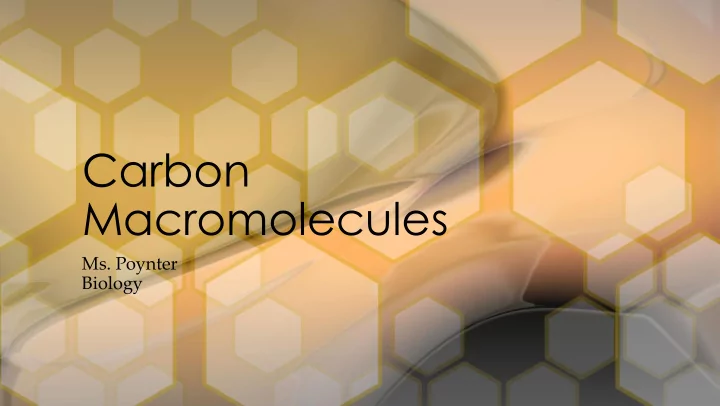

Carbon Macromolecules Ms. Poynter Biology
Chemistry of Carbon • There are 2 reasons that there is a whole branch of chemistry set aside just to study carbon compounds. They are: 1. Carbon atoms have FOUR valence electrons, allowing them to form strong covalent bonds with many other elements . Carbon can bond with many elements, including hydrogen, oxygen, phosphorous, sulfur and nitrogen to form the molecules of life.
Chemistry of Carbon • There are 2 reasons that there is a whole branch of chemistry set aside just to study carbon compounds. They are: 2. One carbon atom can bond to another carbon atom , which gives carbon the ability to form chains that are almost unlimited in length . Carbon has the ability to form millions of different large and complex structures.
Macromolecules • Macromolecules means giant molecules . • Macromolecules are made from thousands or even hundreds of thousands of smaller molecules. • Most macromolecules are formed by a process known as polymerization (many monomers), in which large compounds are built by joining smaller ones together. (think necklace or lego palace! • The smaller units, or monomers , join together to form polymers . • Biochemists sort macromolecules found in living things into groups based on their chemical composition .
Monomers & Polymers • Think of monomers as different colored beads on a necklace, and the polymers as the necklace itself. Monomers Polymers
Monomers & Polymers • OR think of monomers as Legos! Atoms Monomers Polymers
Macromolecules The four categories of macromolecules we discussed in class are: • Carbohydrates • Proteins • Lipids • Nucleic Acids
Carbohydrates • Composed of Carbon (C), Hydrogen (H), and Oxygen (O). • Include Monosaccharides (Simple Sugars) Candy and sugar makes kids and Polysaccharides (Complex Sugars) hyper, but the short term energy source leads to hard • Glucose, sucrose, fructose, and cellulose . “crash” • Source of short term energy storage . • Examples include: Potatoes (complex), candy (simple), rice, pasta, fruit sugars, milk sugar, etc.
Carbohydrate Monomers & Polymers • If we used the necklace example for carbohydrates, it might look like this: C, H, O Monosaccharides Polysaccharides simple sugars Complex sugars and starches Atoms
Proteins • Composed of C, H, O, and Nitrogen (N) • Assembled from Amino Acids • Create enzymes which make chemical reactions happen in living things • Make cell structures and parts • Transport substances into and out of cells • Help fight disease • Examples include: Hair and Enzymes
Protien Monomers & Polymers • If we used the necklace example for proteins, it might look like this: Amino Acids Type of Protein
Lipids Bears eat a lot of food right before hibernation to “fatten up” so they have an energy storage during winter. • Composed of C, H, & O • Has a glycerol and a fatty acid • NOT soluble in water • Two types: Saturated and Unsaturated • Source of long term energy storage. • Make up the cell membrane • Examples include: fats, oils, waxes, and steroids.
Unsaturated Lipids • Unsaturated fats come primarily from plant foods like nuts and seeds • Are liquid at room temperature. Ex. include vegetable oils such as olive, peanut, safflower, sunflower, soybean and corn. • Do not raise blood cholesterol or low-density lipoprotein levels.
Saturated Lipids • Saturated fats Most come from animal sources such as animal meat and products, however several come from plant sources, like coconut, palm and palm kernel oils. • Are normally solid at room temperature. • Saturated fats raise levels of both total blood cholesterol and low-density lipoprotein, or “bad” cholesterol. • Elevated low-density lipoprotein is associated with an increased risk for developing cardiovascular disease.
Lipid Monomers & Polymers • If we used the necklace example for proteins, it might look like this: Glycerol & Fatty acids Type of lipid
Nucleic Acids • Composed of H, O, N, C, & P • Made up of a Nitrogen base, a sugar, an a phosphate group • Stores genetic information • Examples include: RNA, DNA, and ATP
Nucleic Acids • DNA
Recommend
More recommend